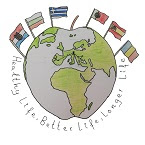Πρόγραμμα eTwinning: Traditional Games and Sports
Πρόγραμμα Etwinning (τάξη Γ’2, 2019-20)
“Traditional Games and Sports”
Δραστηριότητα : Σημαίες χωρών
Τάξη Γ’2
(Υπεύθυνη εκπαιδευτικός : Κατσαουνίδου Αναστασία)
Flag of Hungary
The red, white and green tricolour was adopted as the basis for the Hungarian flag around the time of Hungary’s failed revolution in 1848 although the colours come from the Hungarian Coat of Arms, which dates back centuries earlier. The flag design is made up of three thick horizontal stripes, with the colours said to indicate strength (red), faithfulness (white) and hope (green). There are also suggestions that the red represents the blood shed in past battles, white represents freedom or the country’s rivers, while green represents the lush, fertile land of Hungary.
Flag ALBANIA
“The red color of the Albanian
flag represents the blood and the black - the color of the eagle.
The eagle represented pride, freedom and strength.
In ancient times it is even said that Zeus fed the milk of Amalfi's goat
brought by the eagle, ie. was nourishing the gods.
Smaila Meskovic - The flag of Bosnia and Herzegovina
The flag of Bosnia and
Herzegovina contains a wide medium blue vertical band on the fly side with a
yellow right triangle abutting the band and the top of the flag. The remainder
of the flag is medium blue with seven full five-pointed white stars and two
half stars top and bottom along the hypotenuse of the triangle.
The three points of the triangle stand for the three main ethnic groups (or
"constituent peoples") of Bosnia and Herzegovina: Bosniaks, Croats,
and Serbs.[2] The triangle represents the approximate shape of the territory of
Bosnia and Herzegovina.[3] The stars, representing Europe, are meant to be
infinite in number and thus they continue from top to bottom. The flag features
colors often associated with neutrality and peace – white, blue, and yellow.
They are also colors traditionally associated with Bosnia.[3] The blue
background is suggestive of the flag of Europe.
Flag of Croatia
The flag of the Republic of
Croatia consists of three colors: red, white and blue with the coat of arms of
the Republic of Croatia in the middle. The colors of the flag are laid out
horizontally, in this order on the upper side: red, white and blue.
COAT OF ARMS
consists of 2 parts: shield and crown
shield - 25 red and white quadrats(13 red)
crown-5 smaller coats of arms:
1. The oldest Croatian coat of arms
2. Dubrovnik coat of arms
3. Dalmatian coat of arms
4. Istrian coat of arms
5. Slavonian coat of arms
Greek flag
The national flag of Greece,
popularly referred to as the "blue and white" (Greek: Γαλανόλευκη, Galanólefki) or the "sky blue and white" ( Κυανόλευκη, Kyanólefki ), is officially recognised by Greece as one of its national
symbols and has nine equal horizontal stripes of blue alternating with white.
There is a blue canton in the upper hoist-side corner bearing a white cross;
the cross symbolises Eastern Orthodox Christianity, the established religion of
the Greek people of Greece and Cyprus.
According to popular tradition, the nine stripes represent the nine syllables
of the phrase "Ελευθερία ή Θάνατος" ("Freedom or Death"), the five blue stripes for the
syllables "Ελευθερία" and the four white stripes "ή Θάνατος". The nine stripes are also said to represent
the letters of the word "freedom" (Greek: ελευθερία).
White and blue have been interpreted as symbolising the colours of the famed
Greek sky and sea.
Flag of Serbia
The Serbian flag features horizontal stripes of equal thickness in the traditional Pan-Slavic tricolors: red (top), blue (middle), and white (bottom). These Pan-Slavic colors represent the revolutionary ideas of sovereignty. Red signifies the blood shed during the struggle for freedom, blue denotes the clear sky, and white signifies dazzling bright light. Serbia's coat of arms includes a principal shield and a smaller red shield, and is placed toward the hoist side of the flag. The main field of the coat of arms represents the Serbian state. It also displays a two-headed white eagle and fleur-de-lis next to each talon, which are considered historic dynastic symbols. The smaller red shield on the eagle represents the nation of Serbia and is divided into four equal quarters by a white cross. A royal crown is featured above the head of the eagle, which was inspired by the crown of Serbia.
Flag of Poland
The upper band of the flag means a white eagle, and the lower band means a red field of the coat of arms. The colors of the Polish flag have the following meanings. White means silver, as well as water and purity. Red is a symbol of fire, it means courage and bravery.
Georgia
Flag itself represents a white
cloth with five red crosses, one central (St. George) and four equilateral
(Bolnisski) crosses in the four quadrants. Rectangular and four small cross on
a white background are the general Christian symbols that embody Jesus Christ
the Savior and the four evangelists.
This general Christian symbols, as a heraldic sign was first recorded in 1099
on the arms of crusader Godfrey Bouillon, this way he was given the title of
defender of the Holy Sepulcher. Ever since, this heraldic symbol was the
personification of the Holy Sepulcher and also the centre of Christianity - Jerusalem.
It is known by three names - Godfrey Bouillon’s emblem, Jerusalem’s emblem and
the Holy sign. White color in heraldry indicates innocence, purity, wisdom, and
red color signify courage, bravery, justice and love.
































